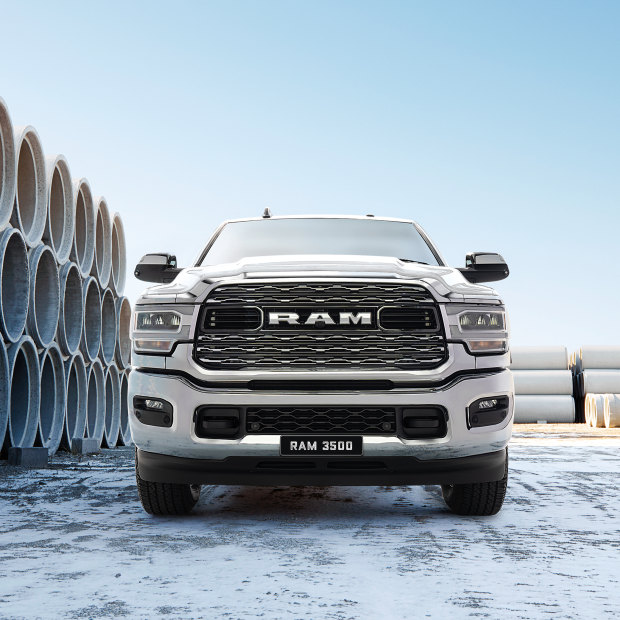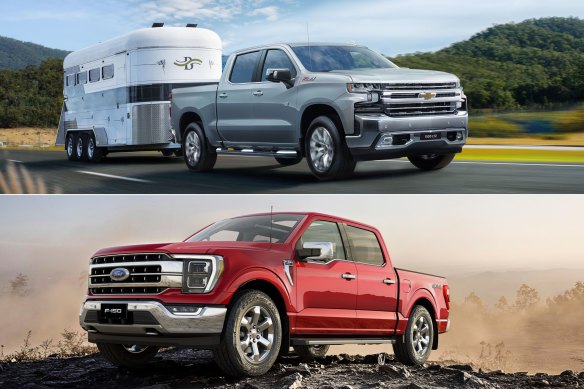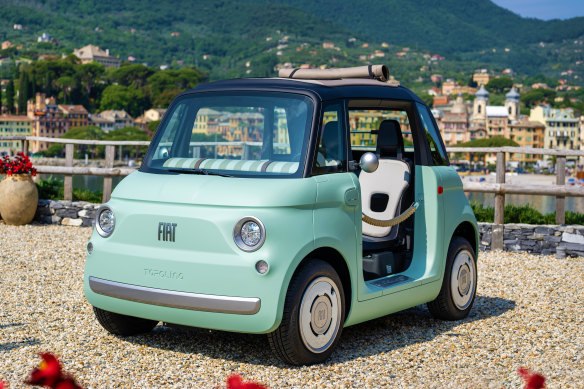This was published 1 year ago
Side windows at neck height: The madness of super-sized pick-ups
Australians are taking the lead of Americans in our growing penchant for super-sized pick-up trucks. Some Europeans, meanwhile, are moving in the opposite direction.
By Tony Davis

The biggest RAM, the 2500/3500 series, weighs about 3.6 tonnes.
It’s a sunny winter morning in the southern suburbs of Sydney, and at the Tynan Motors car yard there are six monster US pick-ups in a row. They make even the nearby Jeeps, SUVs and regular utes look tiny. Most are RAM 1500s, which are huge enough, but to the right is an even bigger bopper, a RAM 2500. It’s well over six metres long, has a stonking great diesel V8 engine and weighs more than twice as much as a typical family SUV.
I’m tall, yet the chromed grille almost reaches my shoulder. The side windows start at neck height. It’s hard not to think of The Simpsons’ Canyonero, “Twelve yards long, two lanes wide, 65 tons of American pride!”
The young salesman, Hugo, knows I’m not a potential buyer, but he’s happy to go through his routine. He opens doors, points to features, extols the roominess, the comfort and the towing capacity. He stresses, again and again, just how much people love the size. The 1500 range starts out at “about $96,000”, Hugo says, but most spend about $170,000 on the RAM Limited model. As I hoick myself up into the Limited’s driver’s seat, I hear about the advantages of adjustable air suspension, 360-degree cameras, a Harman Kardon sound system, leather-trimmed seats with heating and cooling built in. “Absolute luxury,” Hugo says. “There are three anchor points in the back as well, so you can actually fit three baby seats.”
The US pick-up truck category, which took off in Australia with the launch of the RAM in 2015, is hot. Australians bought a record 5724 RAMs and Chevrolet Silverados in the first half of 2023, up 65 per cent on the same period last year. That’s still only a small percentage of the new vehicle market, but no other style of vehicle is growing as quickly. Other makers are trying to catch up. Ford’s F-Series pick-up is imminent, priced from about $107,000, and the company is reporting strong advance orders. The similarly sized Toyota Tundra should go on sale early next year. All are manufactured in the US, where pick-ups have dominated the sales charts for more than 40 years.
Jeff Barber, RAM Trucks Australia’s national manager, is effusive about what US style pick-ups offer, and why their popularity is increasing: “[They enable] a range of customers to travel business class whether they’re towing, on work sites, on family road trip adventures or even doing the school run.”
Why do people buy these things? I could find no local research and had to turn to an American with English and Australian antecedents to find out. Alexander Edwards is president of Strategic Vision, a market research company that surveys more than 200,000 new vehicle buyers in the US annually. Edwards is not one to give an answer that’s brief or bereft of figures. Fortunately, he agrees to summarise his arguments. Via video call from his Californian office, the fresh-faced 50-something believes that Australian and American buyers have many of the same values and priorities. The workhorse ability of pick-ups is important in rural and regional areas of both continents because they can carry and tow much greater loads than regular utes. In such places, “If the truck can’t do job A, it doesn’t matter what the image is.” Pick-up trucks are also about protection, real and perceived, about “keeping my tribe safe” including from crime and political unrest. “Size is a cue of security.”
“They get a vehicle that says, ‘I may not go off camping but I could, if I wanted to.’ ”
Alexander Edwards, president of US market research company Strategic Vision
But it’s not only people who need to cart farm equipment or tow a four-horse float that are buying such vehicles. Edwards turns to his screen and reads out some figures: 31 per cent of American pick-up owners never tow, 30 per cent never go off road and 11 per cent never put anything in the tray. For many who do, it might be just once a year. He says buyer motivation in the US breaks roughly into thirds: those who need the capabilities, those who are buying on image and those who are in between. “There are people out there, and it’s more often a male, who is married, who has kids still in the home, has a nine-to-five job or is an entrepreneur … they never have the time to go out and do the things that they want to do. So they get a vehicle that says, ‘I may not go off camping but I could, if I wanted to.’

The Chevrolet Silverado (top) and Ford’s F150 – both big sellers in the US – are being imported and converted to right-hand drive.
“They’re taking care of business, they’re feeding their family, their doing the work they need to do … Because they’re the ones who they feel the buck stops with them, [they say], ‘I want a vehicle that can do whatever I want to, because I need that to feel good about all those other sacrifices I make.’ ”
Pick-ups might be the most extreme example, but Australians are opting for bigger and bigger vehicles, year by year. The Toyota HiLux and Ford Ranger utes regularly top our bestseller lists; indeed, more than three-quarters of new vehicles we buy are SUVs or utes, making the traditional sedans and wagons bit players. But US-built pick-up trucks are on a different scale, literally.
The Ram 1500 TRX is advertised as THE APEX PREDATOR OF THE PICK-UP TRUCK WORLD. Yes, in all-caps. The advance blurb for the Ford F-Series says simply, “This is Going to Be Big”, while the HSV version of the Chevrolet Silverado’s Australian website declares, “These heavy-duty trucks perform as aggressively as they look.”
Pick-up advocates tend to be passionate, likewise their critics. It doesn’t help that, just before Good Weekend speaks with him, Professor Peter Newman has exchanged words with a driver of “one of those extraordinary things”.
He explains, “In my street in inner-city Fremantle, there was enough space for three cars and I parked in the middle with space for one in front and one behind, and this big burly thing came up behind me and just sort of half-parked. The man leaned out and said, ‘Please move forward, I need to take these two spots.’ I said, ‘What are you driving a thing like that for here?’ and he got very angry and said, ‘Move your bloody car or I’ll push it out the way.’ ”
Newman, professor of sustainability at Perth’s Curtin University, says big SUVs and pick-up trucks often block the vision of other drivers and waste space and resources, and that’s before climate change is even considered with their fuel use. “They’re just so big,” he says, joking, “I can fit in the back with my Toyota Prius.” He adds, “And there’s always one male in it, and that’s it.”
The self-declared activist academic has been campaigning since the 1980s for walkable cities. These, Newman says, are not only more liveable but generate far more wealth. He points to Copenhagen and Vancouver as the kind of cities Australia should be modelling its future on. But huge vehicles tend to
undermine any good work in this direction. “In dense, traditional city centres and inner cities, they are completely inappropriate.”
The emergence of the pick-up as something other than a work vehicle can be traced to 1964 and a 25 per cent tariff imposed on “light trucks” imported into the US, most notably the top-selling van and pick-up versions of Germany’s VW Kombi. This was the then US President Lyndon B. Johnson’s revenge for a European impost on US poultry, but the “chicken tax” stayed and the US automotive industry gravitated towards producing pick-ups with passenger comforts and marketing them to regular consumers.
Conveniently, these trucks have also been given an easy ride on emission and safety legislation, the latter despite vehicles with a high centre of gravity having compromised handling, and those with high bonnets being deadlier. A report by the US’s Insurance Institute for Highway Safety in April said such vehicles were more likely to knock cyclists down (rather than flick them up), “where they can be run over by the vehicle as the driver attempts to stop”.
Yet the Ford F150 pick-up is the single bestselling vehicle of any type in the United States, with the Chevrolet Silverado second and the RAM third. All three are built with left-hand drive, but that doesn’t stop companies shipping them to Australia, pulling them apart and adding hundreds of bespoke new parts to convert them to right-hand drive. So much so, they are the foundation of our new motor industry, employing more than 1000 assembly line workers, mostly with Victoria-based contractor Walkinshaw.
Australia has no fuel efficiency standards and new combustion vehicles sold here have improved their average emissions by only a few per cent in the past decade. In April, the Minister for Climate Change and Energy, Chris Bowen, said that Australian new cars use 40 per cent more fuel on average than those in the European Union and promised to introduce fuel efficiency standards. But progress is slow: draft legislation is only expected by the end of the year and the department confirms any new laws will be framed “to protect the continued sale of vehicles Australians love, such as utes and four-wheel drives”. Whether pick-ups will even be included is unclear.

The Fiat Topolino, top speed 45 kilometres per hour, is creating excitement in Europe but like other electric quadricycles is banned from Australian streets.
Some see hope in electrification. But, with current technology, batteries make pick-ups even heavier and even more brutal in a collision. They also reduce the payload, drastically cut the range when towing and increase the price. And electric pick-ups still take up just as much space.
Is there any way to reverse the trend to ever-bigger vehicles? In European cities such as Paris and Rome, the electric quadricycle is providing one solution. With a classification between a motorcycle and a car, these four-wheel micro-vehicles have a maximum speed of 45 kilometres an hour. Primarily two-seaters, their light weight means even a small battery pack can give them a range of 70 to 80 kilometres. They can be parked nose to curb, two or three per a regular car space. Another benefit: in many cases they are 50 per cent cuter than a button. Look no further than the new Fiat Topolino, which is also available in a Dolcevita version, with roll-back roof and nightclub-style velvet ropes for doors.
Clearly they aren’t going to mix safely with pick-ups or even regular utes and SUVs. Professor Newman’s solution is to ban larger private vehicles from city centres in favour of electric micro-mobility, which is to say scooters, e-bikes and quadricycles. “You don’t put these quadricycles on freeways,” says Newman. “The SUVs will eat them up. But in cities there are no great safety risks because they don’t get to any great speeds, they’re just helping to make it all work.”
That’s not happening anytime soon, however: a spokesman for the federal Department of Infrastructure and Transport tells Good Weekend that there are no plans to change the rules to allow quadricycles on Australian roads because they don’t offer the crash performance of regular cars. That they are safer than a motorcycle, clean running, relatively affordable, have weather protection, can be used by people who would not be confident on two wheels, are less likely than pick-ups to injure others and could help unchoke our cities appears unlikely to get them over the line.
To read more from Good Weekend magazine, visit our page at The Sydney Morning Herald, The Age and Brisbane Times